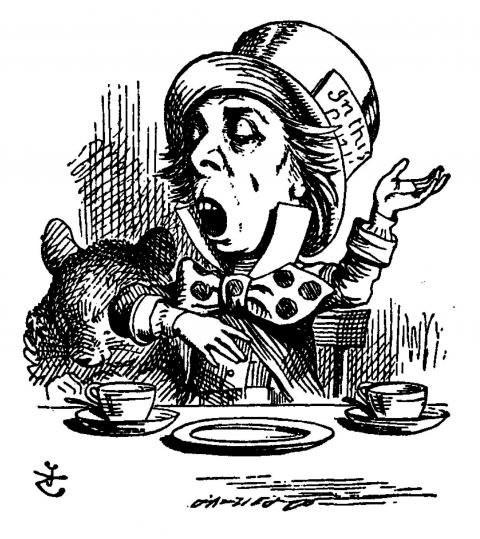Chinese practice
瘋瘋顛顛
be mad/eccentric

Photo: Wikimedia Commons
照片:維基共享資源
(feng1 feng1 dian1 dian1)
「mad as a hatter」(跟帽匠一樣瘋狂)這個說法,一般多認為是跟路易斯‧卡羅(一八三二~一八九八年)一八六五年的小說《愛麗絲夢遊仙境》中之角色──帽匠有關。我們知道卡羅並未自創此語,因為它在卡羅寫作此書時就已存在了。但其實此語之原始形式、起源,甚至實際意義等,幾乎都是有爭議的。
首先,卡羅並未使用「mad as a hatter」這樣的說法。他書中有一角色名為帽匠(Hatter),他在書中插圖的形象是戴著一頂誇張的超大禮帽。卡羅筆下的帽匠是個古怪外向的人,我們由書中角色柴郡貓(Cheshire Cat)的口中,知道帽匠的確是瘋了,但卡羅從未稱他為「Mad Hatter」(瘋帽匠),也沒有使用「as mad as」(跟...一樣瘋)這樣的句型結構來描述帽匠。
公認的說法是,「mad as a hatter」指的是在法國、英國和後來的美國,製帽的工匠由於暴露在含汞的工作環境中,因汞中毒而變得「瘋狂」。汞中毒的影響包括生理和心理的疾病,包括震顫(稱為「hatters’ shake」(瘋帽顫))、言語障礙、情緒不穩定──過度膽小、怯懦及害羞、失去自信、畏首畏尾怕被別人注意、病態地極度害怕被嘲笑、被批評時爆怒──以及幻覺。這些在十九世紀的法國和英國都有文獻記載,汞的替代品也同時被找到了。然而,美國的製帽業仍繼續使用汞,直到第二次世界大戰,汞被改用在製造戰爭所需之引爆裝置為止。
H. A. 沃淳在一九八三年十二月的《英國醫學期刊》上發表的文章〈Did The Mad Hatter Have Mercury Poisoning?〉(瘋帽匠是否為汞中毒?)中指出,卡羅筆下古怪外向的帽匠並沒有表現出汞中毒的症狀,而許多跡象顯示,事實恰恰相反。
有很多種說法是以「mad as a…」(跟...一樣瘋狂)為句法結構,且在《愛麗絲夢遊仙境》成書之前就已為人所知了。例如「mad as a March hare」(跟三月野兔一樣瘋狂)──意指古怪反常,以及「mad as a wet hen」(跟淋濕的母雞一樣憤怒)──意指大怒。
「mad」一字亦具有的「大怒」或「生氣」的意義,為我們指出「mad as a hatter」另一可能之出處。埃利澤‧愛德華在一八八二年所發表的《Words, facts, and phrases; a dictionary of curious, quaint, and out-of-the-way matters》(詞、事實及片語──奇特、古怪與冷僻事物詞典)一書中,指出「atter」是奎蛇或毒蛇的盎格魯─撒克遜名稱,而且德文「Natter」一字的意思是「asp」(角螲,一種毒蛇),所以這句話很可能是「mad as an adder」(跟奎蛇一樣勃然大怒)的訛誤,而與「hatter」(帽匠)並無任何關聯,其原意更接近「as venomous as a viper」(像毒蛇一樣惡毒)。
其實在一八六五年之前,就有很多片語是以帽匠做比喻,但所比喻的不是帽匠的心理疾病,而是其行為的強度,因此有「as a drunk as a hatter」(跟帽匠一樣酒醉)、「to work like a hatter」(像帽匠一樣工作)、「to lie like a hatter」(像帽匠一樣騙人)、以及「to go at it like a hatter」(像帽匠一樣火力全開去做)等片語。
最後,我們再回到《愛麗絲夢遊仙境》作者路易斯‧卡羅。他任教於牛津大學,且熟知牛津當時一位名叫迪奧菲勒斯‧卡特的家具店老闆。卡特以其古怪而知名,他的鼻子突出、下巴後縮,經常戴著一頂大禮帽,斜斜地戴在頭上。據說卡羅邀請插畫家約翰‧坦尼爾爵士(一八二○~一九一四)來到牛津,去親眼見見這位卡特先生,坦尼爾便據此畫了一幅漫畫,成為《愛麗絲夢遊仙境》中帽匠的著名造型。因此,卡羅絕對沒有自創出「mad as a hatter」一語,而只是在為故事角色命名時玩了個有趣的文字遊戲,用一個為人熟知的片語改造而成。然而從那時起,卡羅便是將「mad as a hatter」中的「mad」一字,與「eccentric」(古怪瘋癲)的意義聯繫起來,而並非指「mad 」字另一意義「angry」(憤怒)。
「mad as a hatter」可以用中文「瘋瘋顛顛」來表達,所著重的是「mad」一字的瘋狂甚或古怪的意思,而非指憤怒。
(台北時報林俐凱譯)
濟公是南宋時期的傳奇和尚,他雖然看起來瘋瘋癲癲,但是大智若愚。
(Ji Gong was a legendary monk from the Southern Song Dynasty. Although he seemed quite insane, his eccentric appearance masked great wisdom.)
他只要一喝醉就發酒瘋,大家都不知道他會有什麼突如其來的舉動,所以只好退避三舍。
(He gets a bit crazy when he drinks, nobody knows what he might get up to, and so they just keep their distance.)
英文練習
mad as a hatter
The term “mad as a hatter” is often associated with the Hatter in Lewis Carroll’s (1832 – 1898) 1865 novel Alice’s Adventures in Wonderland. We know that Carroll didn’t coin the term, as it predates his novel. In fact, almost everything about the phrase is contested, from its original form to its origins and even its actual meaning.
First of all, Carroll didn’t use the term. He had a character named the Hatter, whose caricature depicted him as wearing an oversized top hat. Carroll’s Hatter was an eccentric extrovert, and we are reliably informed in the novel by the Cheshire Cat that the Hatter was mad, but Carroll never called him the “Mad Hatter,” nor did he use the “as mad as a” construction to refer to him.
Second, there is a common conception that “mad as a hatter” referred to the effects of mercury poisoning that hatters were exposed to in France, England and, later, the US. The effects of mercury poisoning included physical and mental ailments, including tremors (called “hatters’ shakes”), speech problems, emotional instability — excessive timidity, diffidence and shyness, loss of self confidence, a desire to remain unobserved and unobtrusive, a pathological fear of ridicule and explosive loss of temper when criticized — and hallucinations. This was documented in both France and Britain over the course of the 19th century, and alternatives to mercury were found. Mercury continued to be used in the hat making industry in the US until World War II, however, when it was redirected to the war effort for the making of detonators.
As H. A . Waldron noted in his article Did The Mad Hatter Have Mercury Poisoning? published in the British Medical Journal in Dec. 1983, the eccentric extrovert of Carroll’s Hatter exhibited none of these symptoms, and in fact was quite the opposite in many cases.
The construction “mad as a…” came in many forms, and were known prior to Alice. Two examples are “mad as a March hare” — meaning eccentric — and “mad as a wet hen” — meaning livid.
The idea of the “mad” meaning livid or angry brings us to yet another possible origin of the phrase. In Words, facts, and phrases; a dictionary of curious, quaint, and out-of-the-way matters, published in 1882, Eliezer Edwards notes that atter was the Anglo-Saxon name for an adder or viper, and that the German word Natter means asp, so that the saying could well be a corruption of “mad as an adder,” had nothing whatsoever to do with hatters, and that its original meaning was closer to “as venomous as a viper.”
In fact, there are plenty of examples prior to 1865 of similes involving hatters that refer not to their mental ailments but to the intensity with which they undertook a task: so, we have “as a drunk as a hatter”; “to work like a hatter”; “to lie like a hatter”; and “to go at it like a hatter.”
Finally, and back to Lewis Carroll: the writer was an Oxford don, and would have been familiar with the sight of a furniture store owner in Oxford at the time named Theophilus Carter. Carter, with a reputation for being an eccentric, had a protruding nose and receding chin, and would often have a top hat, worn at an angle, perched on his head. It is thought that Carroll invited the illustrator Sir John Tenniel (1820 – 1914) to Oxford to see Carter for himself, and to draw a caricature that became the iconic image of the Hatter in Alice. Carroll, then, far from coining the phrase “mad as a hatter,” was merely using a known phrase in amusing word play in the creation of a character for his novel. From that point on, however, he essentially locked the association of the phrase with the “mad” in the sense of “eccentric” as opposed to “angry.”
In Chinese, we can say 瘋瘋顛顛 to mean mad, in the sense of being insane or perhaps eccentric, but not livid.
(Paul Cooper, Taipei Times)
Take that maniacal look off your face, will you? You look as mad as a hatter, and you’re worrying me.
(你不要看起來這麼瘋狂好嗎?你這樣瘋瘋癲癲的,讓我很擔心。)
I wouldn’t take Tony’s advice if I were you. He’s as mad as a hatter, and so would you be to follow his recommendation.
(如果換做是我,我不會採納東尼的建議,因為他瘋狂古怪,如果你聽他的話,就表示你跟他是半斤八兩。)

Historians are rethinking the way the Holocaust is being presented in museums as the world marks the 80th anniversary of the liberation of the last Nazi concentration camps this month. Shocking images of the mass killings of Jews were “used massively at the end of World War II to show the violence of the Nazis,” historian Tal Bruttmann, a specialist on the Holocaust, told AFP. But in doing so “we kind of lost sight of the fact that is not normal to show” such graphic scenes of mass murder, of people being humiliated and dehumanized, he said. Up to this

When people listen to music today, they typically use streaming services like YouTube or Spotify. However, traditional formats like vinyl records have regained popularity in recent times. Vinyl records are circular discs that store music in grooves on their surfaces and are played on a turntable. As the turntable’s needle runs along these grooves, it picks up vibrations and translates them into sound. The history of vinyl records dates back to the late 1800s, but material and technological challenges delayed mass production until the 1950s. Despite early versions having short playtimes and poor sound quality, vinyl records introduced a new era

A: Brazilian jiu-jitsu, known as “BJJ,” has become more and more popular. Even Hollywood stars like Halle Berry and Tom Hardy are obsessed with it. B: Some Asian stars, such as Taiwanese actor Eddie Peng and South Korean actor Lee Joon-gi, have also practiced this martial art. A: BJJ is not just a martial art, but also a combat sport. B: I’ve always wanted to try it, but I’m worried about getting injured. A: Diana Wang, a US doctor of physical therapy, is holding a BJJ seminar at PMA Brazilian Jiu-jitsu in Taipei Friday night. Let’s go check out how we

Dos & Don’ts — 想想看,這句話英語該怎麼說? 1. 能做的事都做了。 ˇ All that could be done has been done. χ All that could be done have been done. 註︰all 指事情或抽象概念時當作單數。例如: All is well that ends well. (結果好就是好。) All is over with him. (他已經沒希望了。) That’s all for today. (今天到此為止。) all 指人時應當作複數。例如: All of us are interested in his proposal. All of us are doing our best. 2. 我們這麼做有益於我們的健康。 ˇ What we are doing is good for our health. χ What we are doing are good for our health. 註︰以關係代名詞 what 引導的作為主詞的子句,動詞用單數。如: What he said is true. 3. 大家都沿著步道跑。 ˇ Everybody runs along the trail. χ Everybody run along the trail. 註︰everyone 是指一大群人,但在文法上一般用單數。 4. 桌上有一本筆記本和兩支筆。 ˇ There were two